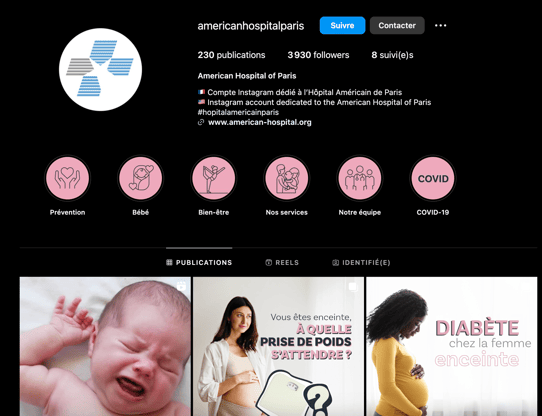Trends and Challenges of Digital Transformation in the Healthcare Sector: Part 2
Digital transformation is emerging as a major revolution in the healthcare sector, redefining the way hospitals, clinics and medical facilities approach healthcare.
In another article, we talked about trends and challenges in the healthcare sector as a whole. In this article, we focus on trends for hospitals and clinics, and how they can meet new challenges.
Digital transformation in the health sector - trends
Digital patient areas
Digital patient areas, also known as online service portals, enable healthcare organizations to modernize their reception and facilitate administrative procedures for their patients.
These areas enable you to carry out a variety of online procedures more efficiently, such as :
- Making an appointment
- Maternity registration
- Pre-admissions
- Download invoices and payments.
As a result, they contribute to faster, more personalized service, requiring fewer staff to liaise between the healthcare organization and its patients.
This more effective communication facilitates care coordination and helps reduce costs.

Big Data Analytics
Big Data analytics plays an essential role for healthcare providers, enabling better interpretation of patient and internal data.
This optimizes care offerings and welcomes more patients. For example, data analysis can be used to identify medication errors and anticipate staffing needs.
In diagnostics, Big Data improves predictive analytics, leading to more personalized treatment plans and better patient outcomes.
Digital pathology
Precise diagnosis of cancers relies on microscopic examination by pathologists.
The digitization of glass slides using scanners enables analysis aided by artificial intelligence, speeding up the interpretation process.
Once perfected, these algorithms can save pathologists precious time when analyzing these images.
France's Institut Curie is at the forefront of this technology, digitizing its slides and analyzing them using the Galen Breast artificial intelligence program from Ibex Medical Analytics.
Strategic use of social networks
Healthcare professionals use social networks to strengthen their ties with patients.
Platforms like Instagram and YouTube are increasingly being used by healthcare organizations to foster interaction by sharing information on a variety of health-related topics.
This helps to educate, reassure and facilitate engagement with communities.

Blockchain solutions
Blockchain brings trust and collaboration to the healthcare sector thanks to its decentralization and inherent security.
Blockchain solutions, such as those offered by IBM enable healthcare organizations to:
- Ensuring data integrity
- See complete traceability of the pharmaceutical supply chain
- Verify health identification information while preserving confidentiality
- Use smart contracts to automate processes such as dispute resolution or medical image review.
3D printing
3D printing offers a low-cost(costs are divided by 1,000 for a hand prosthesis) and promising solution for improving the lives of patients and healthcare professionals.
This technique is used to manufacture lightweight prostheses, advanced medical devices, plasters for fracture healing, even customized organ models and special tools for surgery.

Digital transformation in the healthcare sector - the challenges
Data processing and storage
A major challenge in the healthcare sector is to implement robust systems capable of handling the mass of data collected by healthcare organizations.
For example, the images used by the aforementioned Institut Curie can weigh up to 4 GB (gigabytes, billions of bytes). This represents a huge computer storage challenge, on the order of 120 TB (terabytes, thousand billion) per year.
Data synchronization is an important issue in the context of telemedicine, for example. Visits to the doctor take place via multiple channels, making it more difficult for healthcare professionals to update patients' medical records.
Consequently, it will be essential to create efficient and legal means of recording and updating health records for both in-person and virtual visits.
Legislation, including the EU's RGPD, imposes new requirements on data collection and storage, with very high fines. Fines can reach 20 million euros or 4% of a company's annual sales.
Cyber security
Organizations in all sectors need to remain extremely vigilant in the face of cyber threats, but attacks can be particularly costly for healthcare establishments.
While some threats may come from people seeking to do harm, others may result from errors in the development of a product or software, and companies developing these applications need to ensure that bugs are discovered before their products and systems are launched or updated.
Intuitive user experiences
Whether it's a connected heart monitor, a mobile app or any other digital product or service, ease of use is a major issue for patients of all ages and healthcare professionals alike.
A hard-to-navigate digital patient space, for example, would completely defeat its purpose and simply create more frustration and confusion.
Ultimately, the ability of technology to generate major improvements in the healthcare sector will largely depend on its overall quality, which in turn depends on the extent to which it has passed quality assurance tests, taking into account the needs of the end user.
Staff training to facilitate adoption
Obviously, training medical staff is a fundamental aspect when it comes to digital transformation in the healthcare sector.
Healthcare organizations need to invest in training programs to ensure that healthcare professionals are competent in the use of new technologies.

Mr Suricate - QA testing for healthcare organizations
Ultimately, the success of digital transformation in healthcare is based on the overall quality of the technology that powers it, and that depends on the technology having been rigorously tested.
The no-code SaaS solution Mr Suricate solution covers a wide range of automated tests in order to control your testing and provide your users with the best possible experience.
Take control of your applications and detect bugs in real time on your websites, mobile apps and APIs by reproducing your user paths at regular intervals.





.png)